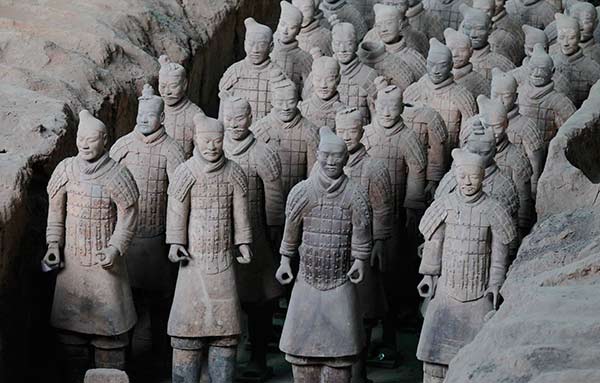 | Terracotta Warriors at the Emperor Qinshihuang's Mausoleum Site Museum in Xi'an,Shaanxi province [Photo by Zhu Xingxin/Asianewsphoto] |
A Chinese archaeologist recently refuted a BBC report about Northwest China'sTerracotta Warriors, saying that the article has quoted her out of context andoverstated her remarks about Western influence on the 8,000 life-size figures. The BBC report, released on Oct 12, said archaeologists have found that inspirationfor the Terracotta Warriors at the tomb of the first emperor near Xi'an, Shaanxiprovince, may have come from Ancient Greece. The article quoted Li Xiuzhen, a senior archaeologist at the Emperor Qinshihuang'sMausoleum Site Museum, as saying, "We now think the Terracotta Army, the acrobatsand the bronze sculptures found on site, were inspired by ancient Greek sculpturesand art." However, Li said that the BBC quoted her out of context, as the article ignoredmuch of what she told BBC reporters. "I think the Terracotta Warriors may be inspired by Western culture, but wereuniquely made by the Chinese. BBC overstated my remarks about Western inspirationand ignored the main points I made during the interview," Li said. Li said the local nature and cultural environment, such as soil, craftsmen andtraditional funeral culture, all contributed to the creation of the TerracottaWarriors. She also pointed out that the article put her quotes right before those ofProfessor Lukas Nickel from the University of Vienna, whose opinion is contrary toher own, but makes it seem as if they share the same idea. According to the article, Professor Nickel said, "I imagine that a Greek sculptormay have been at the site to train the locals." "I am an archaeologist and I value evidence. I've found no Greek names on the backsof Terracotta Warriors, which supports my idea that there was no Greek artisantraining the local sculptors," Li said. |  |Archiver|小黑屋|丝路遗产丝绸之路:长安天山廊道的路网
( 陕ICP备07011065号-3 )
|Archiver|小黑屋|丝路遗产丝绸之路:长安天山廊道的路网
( 陕ICP备07011065号-3 )